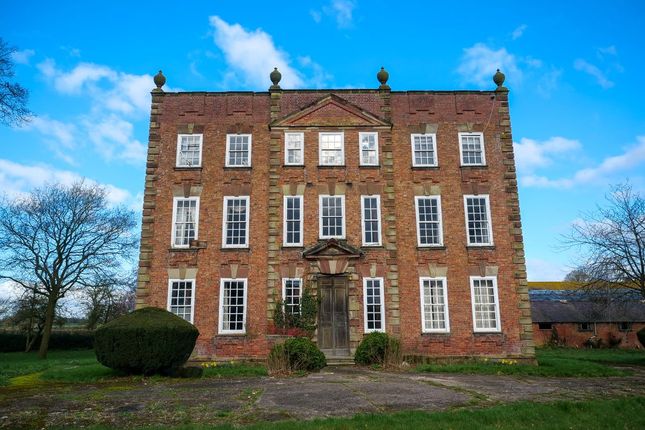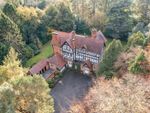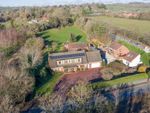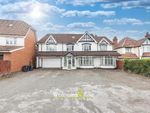Detached house for sale in Longnor Hall, Wheaton Aston Road, Longnor, Staffordshire ST19
* Calls to this number will be recorded for quality, compliance and training purposes.
Property description
For Sale By Public Auction on 16 May starting at 08:30 am - A Freehold Historic Period Manor House with outbuildings for potential development set in 10.12 acres
The opportunity comprises Longnor Hall, a Grade II* Listed manor house dating back to 1726, steeped in history along with a Grade II Listed Coach House, traditional farm buildings, stabling and barns, all set within 10.12 acres (4.1 hectares) of formal gardens and land.
At the centre of the adjacent farmyard lies a Grade II former weighbridge, of red brick construction under a red tiled roof with central finial This building dates back to 1890.
Accommodation
Longnor Hall - Longnor Hall, built in 1726, is a Grade II Listed Georgian manor house steeped in history. The building comprises an 'L' plan formation with a service wing to the rear. It is constructed of red brick in a Flemish bond over three storeys and has a symmetrical and decorative main facade. This features a central Gibbs surround doorway with pediment, and a range of sash windows with central pronounced keystones and brick aprons.
Formal public spaces for the small country house are within the main hall, featuring an entrance hall, dining room, drawing room, library, dressing room and bathroom, as well as eight bedrooms.
A range of early timber panelling survives within the principal rooms and the main bedrooms, as well as original austere fireplace surrounds, many of which feature delft tiling depicting religious imagery.
The service wing features a pantry within the cellar, kitchen and small servants' hall at ground floor level and bedroom with cast iron range at first floor level.
Garden - The front and side gardens currently laid to lawn and there is a concrete front driveway and parking area that leads to the roadside. The front garden is bordered by flower beds and shrubs and a conifer hedge. The property also benefits from a large walled kitchen garden with vegetable beds, fruit trees and a greenhouse. A brick archway leads to the rear courtyard.
Outbuildings - Longnor Hall benefits from a useful range of traditional brick outbuildings. The U- shaped range comprising the stable yard and coach house is positioned around a central courtyard and the Coach House and archway, dating back to 1890, is Grade II listed. The stabling is currently divided into three stalls and a tack room and has a loft over. The buildings are currently used for general storage associated with the house.
Longnor Hall Farm Buildings - Longnor Hall benefits from a useful range of traditional brick outbuildings. The U- shaped range comprising the stable yard and coach house is positioned around a central courtyard and the Coach House and archway, dating back to 1890, is Grade II listed. The stabling is currently divided into three stalls and a tack room and has a loft over. The buildings are currently used for general storage associated with the house.
Land - The land is situated adjacent to the gardens and the drive and comprises a level enclosure of permanent pasture with frontage to the village road. It is bounded to the South by the Whiston Brook.
Traditional Farm Buildings - Included within the sale are a range of farm buildings benefiiting from a previous planning consent for conversion to five residential Units, under planning reference No: 17/00314/full.
The farm buildings are positioned around a covered central courtyard and comprises:-
- Stables with a cobbled floor and loft over
- Range of 8 individual boxes
- A further stable, calf pens and cow stalls
- Old dairy
- Mill and mix area with loft over
- Implement store and cart shed
There is an additional range of more modern barns, that would be demolished under implementation of the above mentioned planning consent. They comprise:-
- Range of Dutch Barns including two 5 bay barns and one 7 bay barn
- Three bay Pole Barn
- Former collecting yard of concrete block construction DeLaval milking parlour and former dairy
- Former cubicle shed of steel frame, block and timber sleeper construction, central feed barrier and dividing gates (75ft x 120ft) - - - Silage Pit, open fronted and of steel frame and timber sleeper construction with a concrete floor (45ft x 120ft)
- Boythorpe grain Silo (100 tonnes)
- Grain Silo (60 tonnes)
At the centre of the adjacent farmyard lies a Grade II listed former weighbridge, of red brick construction under a red tiled roof, with central finial. The building dates back to 1890.
Location
Longnor Hall is the principal manor house in the small rural hamlet of Longnor, a short distance from the village of Wheaton Aston and with easy onward access to the main centres in Staffordshire and the West Midlands conurbation. The M6, M5 and M54 are only a short distance away.
Wheaton Aston provides an array of local facilities, and the house is conveniently situated for easy reach of the further amenities afforded by Wolverhampton City Centre, Stafford and Cannock with the M6 and the M54 motorways being easily accessible and which provide fast access to Shrewsbury, Birmingham and beyond. Rail services run from Stafford with excellent connections to London.
Furthermore, the area is well served by schooling in both sectors in Wolverhampton, Stafford, Newport and Brewood with a highly regarded primary school being situated in the nearby village of Bishops Wood.
Planning
Included within the sale are a range of farm buildings benefitting from a previous planning consent for conversion to five residential units, under planning reference no. 17/00314/full.
There is an additional range of more modern barns that could be demolished as part of the redevelopment of the site.
Rights of way, wayleaves, easements, restrictive covenants etc
The property is sold subject to, or with the benefit of any rights of way, wayleaves, restrictive covenants etc. Which may exist whether mentioned in these particulars or not.
Manor House of Historical Importance
Nestled in the picturesque landscape of Staffordshire, Longnor Hall emerges as a quintessential emblem of England's rich architectural and agricultural heritage. Constructed in 1726, this estate hall represents not just the zenith of architectural elegance of its time but also a living chronicle of the evolving English countryside. As a Grade II* Listed building, Longnor Hall is distinguished not only by its architectural merit but also by its historical significance, standing as a testament to the lives and legacies of its various inhabitants through the centuries.
The hall was built by Ralph Edge, marking a pivotal moment in the architectural landscape of the region. With the initals "R.E.I." gracefully inscribed on a cast iron rainwater head, the hall's construction heralds the meticulous craftsmanship and attention to detail that define the era. The hall's design, characterised by its red brick construction in Flemish bond, symmetrical and decorative main facade, and the elegant proportion of its interiors, reflects a harmonious blend of formality with the functionality of a high-status hall of an estate.
Today, Longnor Hall stands as a beacon of historical and architectural significance. Its Grade II* listing underscores the importance of preserving such edifices, not only for their aesthetic and historical value but also for their role in telling the story of England's rural past.
Historical Timeline of Longnor Hall
The narrative of Longnor Hall is a tapestry of English heritage, stitched through centuries of history, architecture, and the lives of its inhabitants. Its story is not merely about the construction of a building but the evolution of a community and the land it occupies. This timeline encapsulates the pivotal moments.
Early Medieval Period: The name Longnor originates from Old English, meaning 'the long alder copse'. This period marked the establishment of Longnor as a settlement, situated near the main Roman road from London to Wroxeter, hinting at its longstanding signicance in the region.
1086: Documented in the Domesday Book, it was part of the manor of Bradley, showcasing its early agricultural roots and its role within the local feudal system.
15th-16th Century: Longnor remained under the auspices of the manor of Bradley, governed by the Lords of Staord. The Aston family, through strategic marriages, came to own the hall, integrating it into their broader estate holdings.
1687: The manor saw a change of hands from John Fennihouse to William Saunders, setting the stage for the construction of Longnor Hall.
1719: Ralph Edge acquired the manor through marriage to Saunders' daughter, Jane. This union led to the construction in 1726, with its architecture possibly inuenced by Francis Smith of Warwick, a prominent architect of the me.
Early 19th Century: Ownership transitioned to the Edge family descendants, underlining the hall's status as a signicant familial and agricultural seat.
1839: Henry Leaver purchased the estate, initiating a series of substantial modications that enhanced its stature and prestige. This era marked the demolition of earlier structures and the construction of new farm buildings, shaping the estate's current form.
1890: H. Mitchell acquired the estate, contributing further to its legacy through signicant upgrades, including the addition of the Grade II Listed Coach House and Weighbridge House.
Early 20th Century: W.J. Shuker, a notable local agriculturist, tenanted the hall, expanding its agricultural operations signicantly.
1921: The Holt family, under James Holt, purchased the estate, continuing to inuence its development and ensuring its preservation into the modern era.
1962: The Ministry of Housing listed the Hall, recognising its historical and architectural signicance.
2019: The passing of Robert Stuart Holt marked the end of an era but also a connued commitment to preserving the legacy of Longnor Hall.
The Estate and Its Owners
Longnor Hall, a beacon of historical and architectural signicance in Staordshire, has been shaped by the lineage of its owners, each leaving an indelible mark on its structure, land, and legacy. From its origins in the 18th century to its role as a prestigious country estate, it has evolved through the hands of several key families, each contributing to the estate's rich tapestry of history.
The Edge Family: Foundational Inuence
Early 18th Century: Ralph Edge constructs Longnor Hall, embedding his initials "R.E.I." and the construction year, 1726, into the fabric of the building. This marks the beginning of the Edge family's inuence, setting the architectural and historical tone of the estate.
The Leaver Legacy: Expansion and Transformation
1839: Henry Leaver acquires the estate instigating signicant changes that would redene the it. Under his stewardship, earlier structures are replaced with a 'U' plan courtyard of farm buildings, heralding a new era of agricultural productivity and architectural evolution.
The Mitchell Era: Enhancements and Additions
Late 19th Century: H. Mitchell, known for his contributions to the brewing industry, becomes the proprietor. His tenure is marked by the addition of the Grade II Listed Coach House and Weighbridge House in 1890, along with extensive modications to the hall itself, enriching the estate's architectural diversity and heritage.
The Holt Family: Custodianship into the Modern Era
Early 20th Century to Present: The Holt family takes up the mantle, ensuring the preservation and continued relevance of the property. Their period of ownership sees the estate through challenges and changes, including the transition of agricultural practices and the maintenance of its historical and architectural integrity.
Heritage
Longnor Hall, with its origins deeply rooted in the agricultural landscape of Staordshire, has played a pivotal role in shaping the agricultural heritage and land use of the area.
The estate's agricultural legacy is marked by a dedication to both crop production and livestock farming. Throughout its history, Longnor Hall has seen the cultivation of a variety of crops, adhering to the demands of the time and advancements in agricultural techniques. The farming practices implemented on the estate were often ahead of their me, integrating innovations that would set standards for the region.
The story of Longnor Hall stands as a testament to the resilience, innovation, and heritage of rural England. From its origins in the early 18th century to its role in the 20th century and beyond, Longnor Hall has not only been a witness to history but has actively participated in the shaping of the local landscape and community. Each owner, from Ralph Edge to the Holt family, has left an indelible mark, contributing to the hall's rich tapestry of history, architecture, and agriculture.
The hall embodies the essence of continuity amidst change. Its walls have seen the transition from hand farming to mechanised agriculture, from local governance to national politics, and from private residence to heritage asset. Yet, throughout these transitions, Longnor Hall has remained steadfast, a beacon of tradition and progress intertwined.
In the end, Longnor Hall is more than just a building or an estate; it is a living history book, each page filled with stories of people, architecture, and the land.
Auctioneer's Note
The Purchaser(s) deemed to have full knowledge of the boundaries, and neither the vendor nor their agents will be responsible for defining ownership of the boundaries, hedges or fences.
Please note offers may be considered prior to the Auction Sale.
Viewing Times
Strictly by appointment with the Auctioneers.
Live-streamed Auction
Please note that the Auction will be livestreamed via our website. You can take part remotely via Proxy, Telephone or Online, if you wish to bid you must pre-register via our website no later than 3pm the day prior to the auction.
Disclaimer
Bond Wolfe or their Agents for the seller of these Lots give notification that any particulars contained within the catalogue/website are prepared to the best of their knowledge and include information that has been provided to them. Plans, photographs and room measurements (provided via a 3rd party) are provided as guidance only and should not be relied upon. All potential buyers should make their own enquiries and investigations to the accuracy of the information contained in these particulars or to obtain further information that is not provided which they deem to be important prior to bidding. Any amendments to the particulars that Bond Wolfe are aware of will be published on the addendum, which is available within the lot information.
*Definition of Guide Price and Reserve
All properties are sold subject to a reserve price, which is the minimum price the seller is willing to accept and is confidential between the seller and Auctioneer. The guide price is only an indication as to where the reserve is currently set and not necessarily the Auctioneers expectation of what it will sell for. If the guide price is a bracket figure, then the reserve price cannot be higher than the top end of the guide price, if the guide price is a fixed figure, then the reserve cannot be more than 10% above the guide price. The guide price and reserve price can be subject to change at any time up to and including the auction day and, properties can often sell for substantially more than the quoted guide price.
Costs at Auction
When buying at auction you will unconditionally exchange contracts on the fall of the auctioneer's gavel, please therefore ensure you have read the legal pack for each property prior to bidding. They are all individual and include the terms and conditions of your purchase as well as any costs in addition to the purchase price.
The sale of each lot is subject to an administration fee of £1,920 inc VAT (£1,600.00 + VAT) (unless otherwise stated in the important information), payable on the fall of the gavel/at the end of the online auction.
Please note that the administration fee for the Local Authority lots may differ and all interested parties should enquire directly with the Auctioneers as to the fee applicable.
Any additional costs excluding the administration fee will be listed in the Special Conditions within the legal pack and these costs will be payable on completion. Any stamp duty and/or government taxes are not included within the Special Conditions within the legal pack and all potential buyers must make their own investigations. The legal packs and further information about buying at auction are available on the Bond Wolfe's website.
Property info
For more information about this property, please contact
Bond Wolfe Auctions, B3 on +44 121 721 8417 * (local rate)
Disclaimer
Property descriptions and related information displayed on this page, with the exclusion of Running Costs data, are marketing materials provided by Bond Wolfe Auctions, and do not constitute property particulars. Please contact Bond Wolfe Auctions for full details and further information. The Running Costs data displayed on this page are provided by PrimeLocation to give an indication of potential running costs based on various data sources. PrimeLocation does not warrant or accept any responsibility for the accuracy or completeness of the property descriptions, related information or Running Costs data provided here.



















































































































.png)